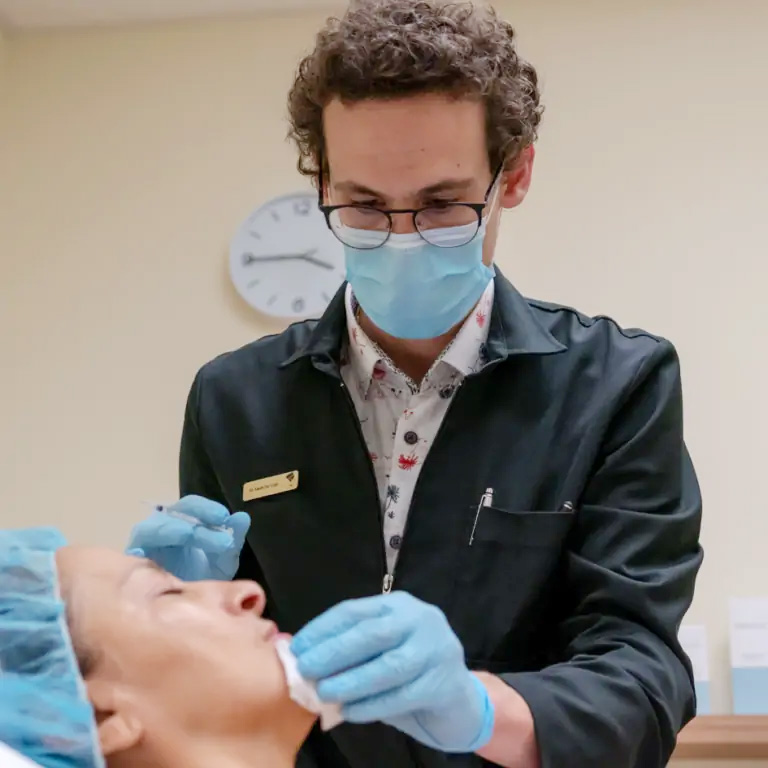Before scheduling your first appointment for injectable treatment, it’s normal to have several questions. We sat down with Dr. Alexis Du Cap, the medical director of the Epiderma network, to ask him a few questions to better understand the effects and workings of these treatments.
What is the difference between neuromodulator and filler injections?
Neuromodulators (Botulinum toxin) Mechanism of action: A medication that works by temporarily blocking nerve signals responsible for muscle contraction, thereby relaxing muscles and reducing the appearance of dynamic wrinkles (caused by repetitive muscle movements). Neuromodulator injections are typically used to reduce the appearance of forehead wrinkles, crow’s feet, and frown lines (glabellar lines).
Dermal fillers (Hyaluronic acid): Hyaluronic acid is a substance naturally present in the human body, particularly in the skin, joints, and eyes. It plays a crucial role in maintaining skin hydration and joint lubrication. In aesthetic medicine, hyaluronic acid is used as a filler to reduce wrinkles, increase tissue volume, and improve skin texture. Mechanism of action: These products fill in hollows, wrinkles, or depressed areas of the face by adding volume, enhancing contours, or giving the skin a more youthful appearance.
In summary, neuromodulators are mainly used to relax muscles and reduce dynamic wrinkles, while fillers are used to restore lost volume, fill static wrinkles, enhance facial contours, and improve skin appearance.
What is the duration of the effects of each of these treatments?
Neuromodulators: The average duration of the product is 3 to 4 months.
Fillers: Duration can vary from 1 year to 2 years depending on the products used and the treated areas.
What are the possible side effects following injectable treatment?
Filler injections may result in redness, swelling, and bruising at the injection site, along with sensitivity, temporary pain, and itching.
Neuromodulator injections can lead to bruising, swelling, or redness at the injection site, along with a sensation of heaviness or temporary muscle weakness. Additionally, headaches and runny nose are rare side effects.
Will people know that I have had injections?
The quality of injections and results depends on the injecting professional. To achieve natural and harmonious results, it is best to choose a trained healthcare professional working in a secure medical environment with experience. A thorough evaluation and a treatment plan tailored to your needs are important. It is also essential to openly discuss desired results with the healthcare professional. Injection results should always be natural and harmonize with your anatomy.
Why do some people seem to have “duck lips” after receiving lip injections?
“Duck lips,” also known as the “duck face,” is an unattractive side effect resulting from lip filler treatment. It typically occurs when too much product is injected locally or when the filler is misplaced relative to your anatomy. This side effect should not occur if your healthcare professional is properly trained and experienced in lip injection treatment.
What happens if I am not satisfied with the result? Is it possible to reverse the effects?
For rare cases of complications or adverse effects, there is an antidote to hyaluronic acid-based fillers called Hyaluronidase, which can be injected to “dissolve” the hyaluronic acid. It is important to note that this antidote is specifically used in cases of confirmed complications or adverse reactions. However, it should not be used as a magic eraser to adjust or reverse a treatment that has not resulted in complications or adverse reactions.
What is the role of medical supervision in injectable treatments at Epiderma?
At Epiderma, only physicians perform injectable treatments. Supervision by the medical management ensures cohesion in clinic-to-clinic treatments, ensures quality of care, provides direct support to injecting physicians, and ensures ongoing training for physicians. Professionals providing care and patients can rely on a complete medical team dedicated to treatment safety.
Is it possible to schedule a consultation appointment at the same time as the treatment?
At Epiderma, it is possible to schedule an appointment with the physician for consultation only, or you can always decide to proceed with the treatment plan on the same day as the consultation, depending on the patient’s choice.
